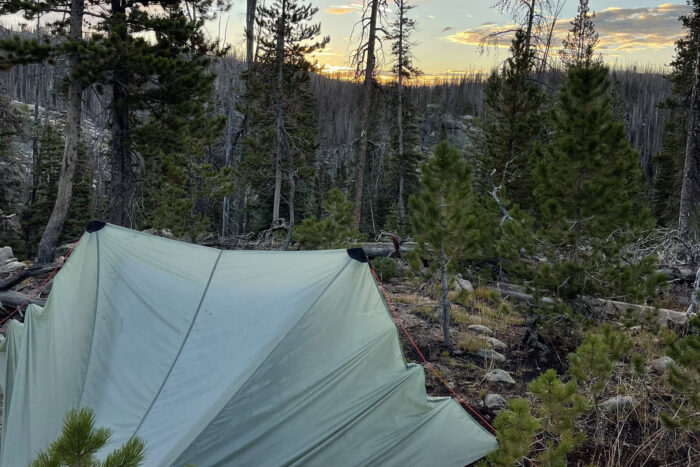Ultralight tents have been all the rage through the past decade or so. It seems that just about every outdoor brand makes one. The problem with cutting back and going minimal is that, if not done right, you can find yourself in the middle of nowhere wishing you had more.
The Seek Outside Silex has everything you need and nothing you don’t. It is simple and gives you options between going ultraminimal and floorless or giving yourself the comfort of the nest.
I have used this shelter for the past two seasons. It’s seen overnight trips in the Adirondacks and chased bugles in the Colorado Wilderness. Your shelter is your home in the wild. It could be one of the most vital pieces of gear when it comes to protecting you and your equipment when the elements become hostile. The Silex makes a solid backcountry home.
In short: There are some incredible ultralight shelters out there, but the Seek Outside Silex stands out in terms of innovation and versatility in an ultralight package.
Testing the Silex

The Silex Tent
Hunting solo was my impetus to explore ultralight designs. I needed a structurally sound tent that was lightweight and simple to deploy. The Silex seemed purpose-built for my application.
It’s primarily a trekking pole shelter, but Seek Outside offers carbon poles should you go that route. You can purchase just the canopy and utilize it as a floorless shelter. I opted for the nest, which gives you the added benefit of protection from bugs and condensation.
The design is super minimalist. It’s different from the freestanding Eureka dome tent I grew up with. The Silex has a stove jack option for those seeking to extend their season.
Who knew some catenary cut silnylon, weatherproofed seams, four primary stakeout points, and a couple of trekking poles were all you needed? Oh, and no zippers.
The Silex Nest
Seek Outside offers a nest for those who do not want to go floorless. It attaches to the inside of the canopy. It doesn’t require any additional stakes.
It’s constructed with a 3-inch bathtub floor and mesh walls. The top layer is Durable Water Repellent (DWR) nylon for protection from condensation. Entry and exit are available through zippered doors on both sides.
Despite the additional weight, I have found the nest adds that layer of comfort in the backcountry that a traditional tent provides. The footprint of the nest easily accommodates your sleep system with room to spare.
Unique Feature

The canopy’s zipperless feature is a proprietary design, and it’s brilliant. Zippers are inherent fail points in most shelters. They are under tension in tightly pitched tents.
Seek Outside’s strategy overcomes this with vestibule doors that open and close vertically on a staked line. You can adjust it with the line lock tension fastener in any position on the line. You can shut the vestibule close to the ground in higher wind conditions.
This feature on this tent style makes a traditional zipper obsolete. Gear access couldn’t be faster, either. If you’re not moving camp, you lift the line lock, and then grab your bow, the day’s worth of food, and pack, and you’re off.
Versatility
Your shelter is your mountain home. Hunting out west, sometimes finding a suitable campsite is a challenge. Not only do you want a flat area to sleep for the night, but ideally, you want that spot not within striking distance of any beetle-kill tree tops.
Unlike a freestanding tent, you can pitch the canopy over ground debris. If you choose the floorless option, you’re only limited by the square footage you need for your sleeping pad. The nest requires little in terms of space as well.
Having a shelter this light and simple to deploy makes breaking down camp a quick task. The Silex is the perfect sunshade for those glassing atop exposed ridgelines and mitigates the need for a separate tarp.
Making the Silex Better
There are no glaring weaknesses in the design. It’s lightweight, and if you still want to save an additional 4 ounces, Seek Outside runs the canopy in Dyneema Cuban Fiber (DCF) twice a year. This weight savings does come with reduced durability. DCF is a higher-tension fabric compared to silnylon.
The setup is simple. There’s some nuance to it that you do not want to struggle with after you log a hard day getting to that first glassing point or in the dark. As with any gear, practice at home before you take it to the field.
Condensation does tend to accumulate. You can use the vestibules to manage airflow to reduce this. The only time I notice the condensation is that early morning exit when the damp silnylon brushes the back of my neck. Good morning!
Seek Outside Silex: Conclusion

Ultralight shelters can quickly set you back upward of $700. The Silex canopy and nest cost $400. You can compress both in a stuff sack about twice the width of a Nalgene bottle.
If it’s dry, I have also just stuffed it in the bottom of my pack, too. Durability is always a consideration for backcountry gear, and the Silex’s materials and construction will see you through multiple seasons of hard use. Its geometry also makes it highly resilient to windy conditions.
As this review might suggest, this shelter is my go-to for solo ventures into the wild. Mountain weather can be unpredictable, and there isn’t much this ultralight tent can’t handle. I’m looking forward to many more seasons with the Silex. It’s going to take something great to make me swap to anything else.
